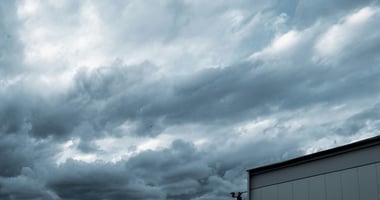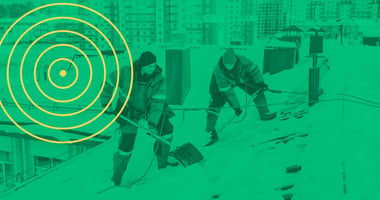3 Feet of Snow on Roofs, It's Worse in Toronto than in Vancouver
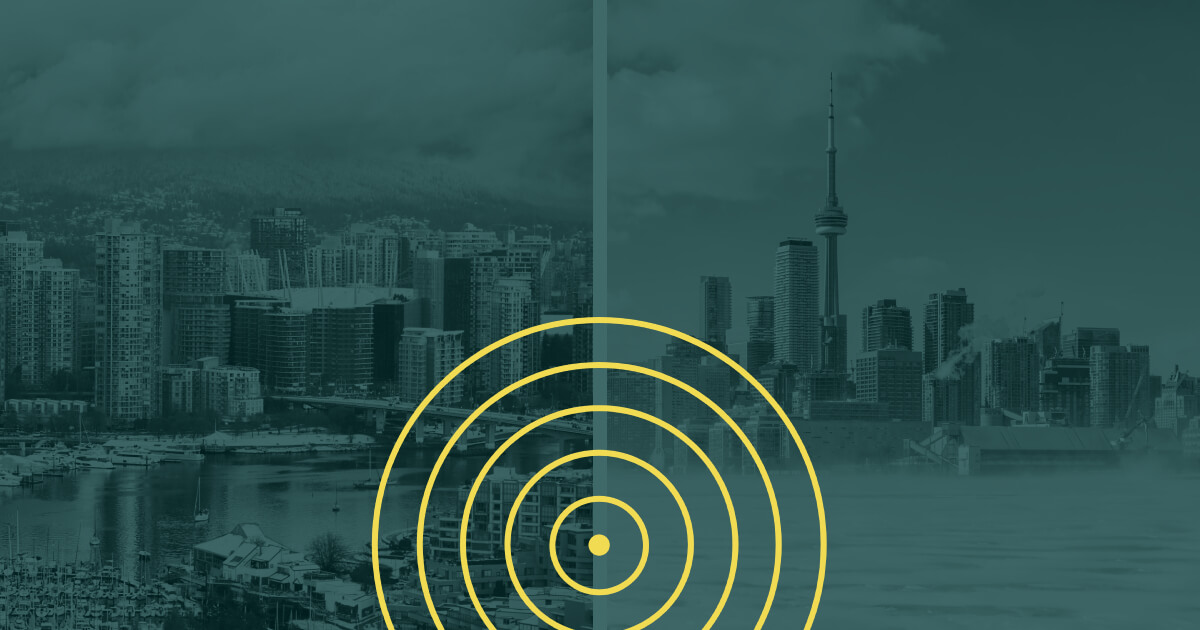
There's a misconception that all buildings throughout Canada can withstand the same snow load. This is one of the reasons why the danger of snow on building roofs is often underestimated.
To raise awareness of this issue among building managers in North America, this article explains why less snow accumulation on a building roof in Toronto should be taken just as seriously as the same amount of snow accumulation in Vancouver.
At Tensio, we like to say that "not all buildings are created equal" since, among other things, snow load capacities vary according to a multitude of factors, most notably the region in which a building is located.
This is all the more important to consider if your organization owns buildings in several different regions of Canada. Decisions about roof snow removal must be made objectively for each building, according to its actual capacity as defined by engineers and according to the National Building Code (NBC), and the building's geographical location; not according to the height of the snow on the roof (which, by the way, is not a reliable indicator at all!).
In other words, the indicators used to define whether or not to launch a snow-clearing operation on a building's roof, or to assess the level of risk posed by snow on a roof, cannot be the same for all buildings.
By way of example, here's why a snow load has a much greater impact in Toronto than in Vancouver for a load of the same weight, notably because the buildings were not built using the same references.
1. Buildings in Vancouver Can Withstand up to 3 Times More Snow Than Those in Toronto
You read that right ! And the reason is simple : 2 to 4 times more snow falls annually in the Vancouver region than in Toronto. This is one of the reasons why, when designing buildings, engineers consult the National Building Code and find that snow loads are 3 times higher in Vancouver.
Irrespective of other design parameters, buildings located in the Vancouver region are therefore designed to be more robust, since they are built to withstand a much higher snow load than those in the Toronto region.
Let's take the example of a snow load applying a pressure of 4 kPa to the roof of a building in Vancouver. The same snow load will not stress the building structure in the same way as in Toronto, even though the load is identical in terms of weight. The level of stress on the structure can become much more worrying in Toronto, since buildings in Vancouver actually have a greater stress capacity than those in Toronto.
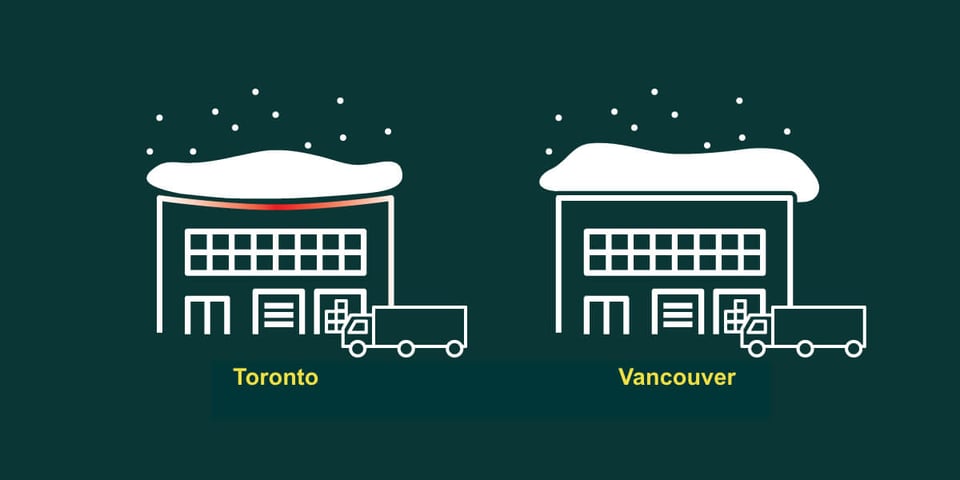
So it's vital to be familiar with the conditions under which your buildings were originally designed and built, in order to determine their actual limits, based on location, era and conditions prevailing at the time of construction.
In doing so, it's not enough to establish the same criteria for an entire building stock that might span several different geographical areas. Not only do codes and standards vary from region to region, but the NBC has also evolved over time, just as the building environment and snow accumulations to which it is subjected has evolved. What's more, on the same roof, limits may also vary according to roof geometry.
Hence the headache for managers trying to figure out when it's time to clear snow from their buildings' roofs!
This Rule Doesn't Just Apply to Vancouver and Toronto
The NBC responds to climatic realities (precipitation, wind, temperature, etc.) in all regions of Canada (so not just by province) and adapts its building construction standards accordingly.
Loading capacities therefore vary according to the region in which your building is located.
In fact, this rule applies not only between Toronto and Vancouver, but in every region of Canada! The standards set out in the NBC vary according to location and year of construction, based on a sampling of precipitation statistics recorded over the past four decades.
As an example, here's a table illustrating the basic loads that buildings must be able to withstand in five Canadian cities located in different regions:
| City | Base Load (kPa)* | Base Load (lbs/ft2)* |
| Toronto | 0,9 | 19 |
| Winnipeg | 1,9 | 40 |
| Montreal | 2,6 | 54 |
| Vancouver | 3,0 | 63 |
|
Whistler (which shows that the buildings of the popular British Columbia ski resort are even sturdier than those of Vancouver!) |
9,5 | 198 |
Do Not Panic, Your Building is Solid, but...
The National Building Code is used as a reference by engineers across the country. Assuming that everything is properly interpreted, the equations, requirements and historical data relating to the loads to be considered enable a balance to be struck between a safe structure, which is desirable, and a design based on excessive safety factors that would lead to a solid, but very costly construction.
In other words, the NBC suggestions, based on precise knowledge of the conditions prevailing at a given location and on the notion of acceptable risk, enable us to strike a balance between safety and economy.
Climate averages evolve much faster than buildings!
The environmental sciences have evolved over the years, as have climatic averages and the legal context, which is not the case for buildings themselves. For example, did you know that it was only in 1994 that Quebec passed a law requiring owners to reinforce attached buildings when they are prone to accumulating snow from neighbouring buildings?
Our team visited a Quebec shopping mall built in the 1960s and expanded in subsequent years, creating several roof levels of varying heights. The instructions at the time were to clear the snow when the accumulation reached 18 feet high on a wall. The same analyses, by today's standards, now require them to clear snow when the accumulation is 3 feet high.
It should also be borne in mind that local anomalies may occur, such as :
- gusts created by rooftop equipment added without modification to the existing structure,
-
neighbouring buildings built later, whose snow is blown onto the roof next door, or
-
a poorly insulated building that causes snow to densify on the roof, further compacting the snow and giving a false sense of security, etc.
These anomalies are worth considering, as they could lead to heavier than expected accumulations of snow on your building's roof. However, it's important to remain vigilant; don't assume that your building can withstand any snow load, at any time.
What's more, the extreme weather events that we've been experiencing in recent years as a result of climate change are having a major impact on building structures. Standards are based on historical values over the past 40 years, but we have to admit that climatic extremes are becoming more frequent, and that the "storm of the century" is now possible every winter.
These climatic anomalies, such as several bouts of snow followed by heavy rain in the middle of February, require managers to keep a closer eye on their buildings. They need to be equipped to demonstrate climate resilience and cope with these unforeseen events.
The reasons behind preventive shutdowns and service interruptions
This is all the more true when it comes to older buildings, or facilities that have undergone several transformations over the years. Managers are aware of the advanced age of their facilities, and question the real impact of "today’s" accumulations. This is why we sometimes see preventive closures of elementary school, arenas that can no longer be used by the public, or factories that have to stop production.
Cracks in the walls or doors that don't close properly = the need for snow removal? Not necessarily!
Some people are also concerned about the appearance of cracks in the walls of their building, or about doors that don't close as easily as they used to. However, these signs don't necessarily indicate overloading of the roof, and vice versa. In other words, just because there are no cracks doesn't mean the roof doesn't need snow removal. So it's not surprising that finding your way around all this quickly becomes a real headache!
2019, a winter sadly known in the Province of Quebec for its many collapses
Just think of the monster snowstorms in Quebec in 2008, or those in 2019, which caused a large number of catastrophic building collapses for several Quebec organizations.
2. The Height of the Snow is Not at All Representative of its Real Weight
What's more (and we can't stress this enough), the height of the snow is not a good indicator of whether or not you need to clear your building's roof of snow; because for the same height, the snow can be heavier or lighter, from one year to the next, from one day to the next, and even from one section of roof to the next.
Read also : Roof Snow Removal: Why Snow Height Is Not a Reliable Indicator
3. The Roof of Your Building Does Not Necessarily Have the Same Load-Bearing Capacity Everywhere
The National Building Code has been renewed over time and adjusted to reflect new environmental realities. This means that two sections of the same building, or two adjacent buildings, may not have been designed to support the same loads, and therefore may not have the same load-bearing capacity.
For example, a building built in 1965 will not necessarily have been designed in the same way as its annex added in 1998, or its extension built in 2015.
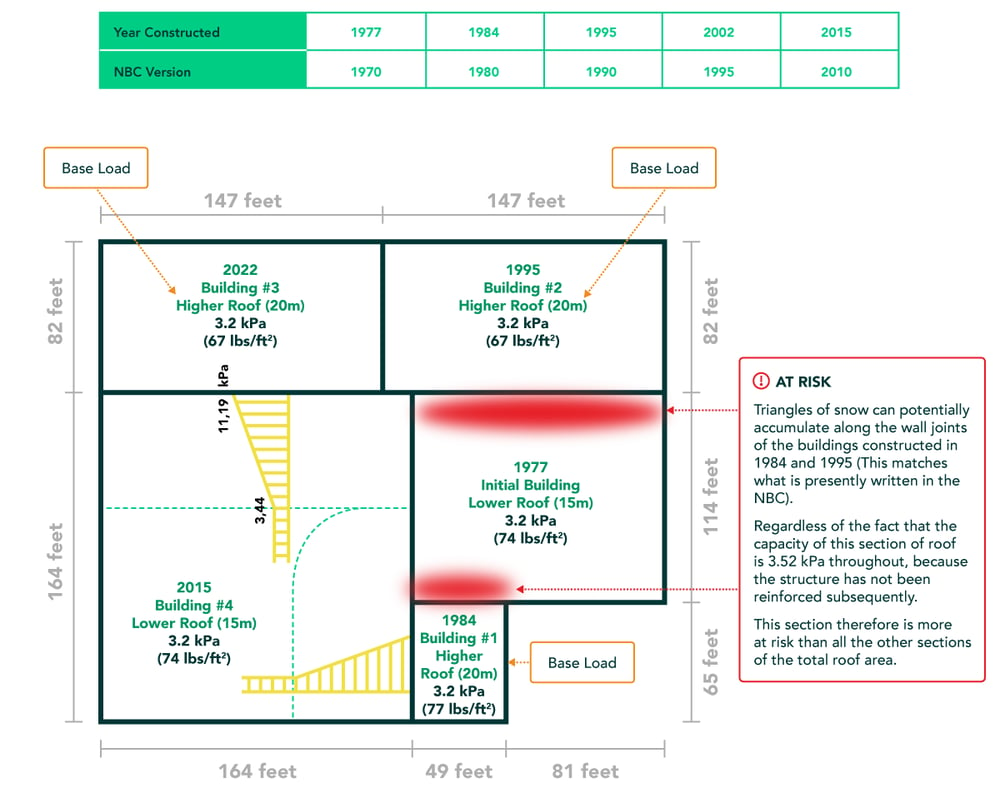
Ensure Optimal Snow Monitoring for All Your Buildings With Tensio
Tensio lets you know exactly what's happening on the roof of your building, 24 hours a day, 7 days a week, taking into account the load on all areas of your roof, as well as future precipitation.
See how Tensio can become your best ally during the winter by discovering our system during a personalized, no-obligation Tensio demonstration. Request yours today.
__
Source :
*National Building Code, 2015 edition
%20(2).png?width=150&height=50&name=Tensio_Logo-SansPositionnement_RVB%20(1)%20(2).png)




